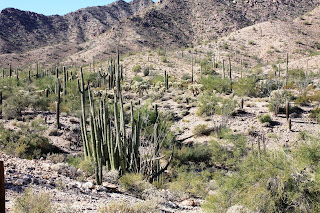Trip meter 74 miles
Benson, AZ
November 30, 2012
Why Benson? Well it's on the cut-off to State Hwy 80 to Tombstone and Bisbee, two high interest sites in SE Arizona. We really don't like driving through major cities, and Tucson is no exception to this rule. That's why we stayed in North Tucson to see the Biosphere2 and why we breezed through Tucson without stopping to get to Benson and camp overnight Thursday and Friday. I say we breezed through, however we did want to make one stop at Camping World to get another pressure regulator for the water hookup- one like the one I inadvertently left behind attached to the faucet in Las Vegas. We had a backup unit, but it was too restrictive. We learned that low pressure and low flow can be, but are not necessarily linked together. Valterra makes a line of regulators that gives 15-20% more flow at less than 40psi, and that was what we were after. This Camping World store is INCREDIBLE! It has more stuff in stock than anywhere we've seen before and we've see a lot of RV stores. Needless to say, we broke our budget going in for a $16 dollar item and leaving an hour later, with $95 worth of treasure.
Back on the road again, we were in Benson within an hours time. After setting up camp and having lunch, we loaded up the car and drove 27 miles south on route 80 to see the historic old west town of Tombstone. It's Touristy- yeah, but we wanted a little whimsy with our history. Here's what we saw:
3 blocks of old town are barricaded for walking only. When you step past the barricade, you step back in time to 1881. There are many actors in period dress and all the shopkeepers were in period garb. You could take a ride in the stage coach and the driver would tell you all about the history of the town. (we didn't)One particular store I was fascinated with, had period weaponry that were all replicas of the real thing, from guns, to knives and swords.
Joan caught me checking out the action on a Colt 45 six shooter- it felt absolutely real, the cylinders revolved, the hammer would cock and fire with a trigger pull and it felt very heavy. In the end I couldn't for the life of me decide why I needed one.Next up is a picture of the front of Big Nose Kate's Saloon.
Kate was the common law wife of Doc Holliday, friend of Wyatt Earp. Throughout the time we were there, gunfighters roamed the streets drumming up business for the "Gunfight" at the OK Corral. Admission $10/person- we were way over our budget and declined.We were very interested in one modern aspect of this old town. These were the first solar electronic compacting trash cans we'd ever seen
This is not a joke or a gimmick- this is the real thing, with photo-voltaic cells on the top to power it.On Friday we drove further south on Route 80 to about 12 miles from Mexico to the Historic mining town of Bisbee. We had called ahead yesterday to make reservations for a tour of the Queen Mine.
Bisbee is a very interesting and unique.town that is situated in a very steep gorge at 5,538 feet in the Mule Mountains.
The whole downtown has been kept to period style, which is a mixture of Victorian and Art Deco, with a little Mexican adobe. We signed up at the Queen Mine to take a tour into the old mine shafts. You've got to get dressed for the 47 degrees and pitch dark We each got slickers, a hard hat, and a light that we wore on a strap around our neck.We rode what looked to be an actual crew car 1800 feet into the mountain.
It was a little spooky because the shaft is very narrow- they warn you not to wave or point with your arms, because we pass very close to the vertical timbers in the shaft."Blondie" as our tour guide calls her steals the show with the dynamite stick.
Okay- big fascinates me, and it rarely gets bigger than this. Another open pit mine- this one called the Lavender Mine, not having anything to do with the colors actually but named for the first General Manager. Nice color in the water down at the bottom eh? Anyone for a chemical swim?Joan loved the look of these brick stairs.
We had lunch in the Savory Spot cafe just below the house that was serviced by the brick stairs. The patio was semi shady and a very pleasant place to rest and by 2 in the afternoon- we were hungry. Joan takes this alleyway as a short-cut between the two main streets.On to New Mexico tomorrow
Jeff and Joan

















































